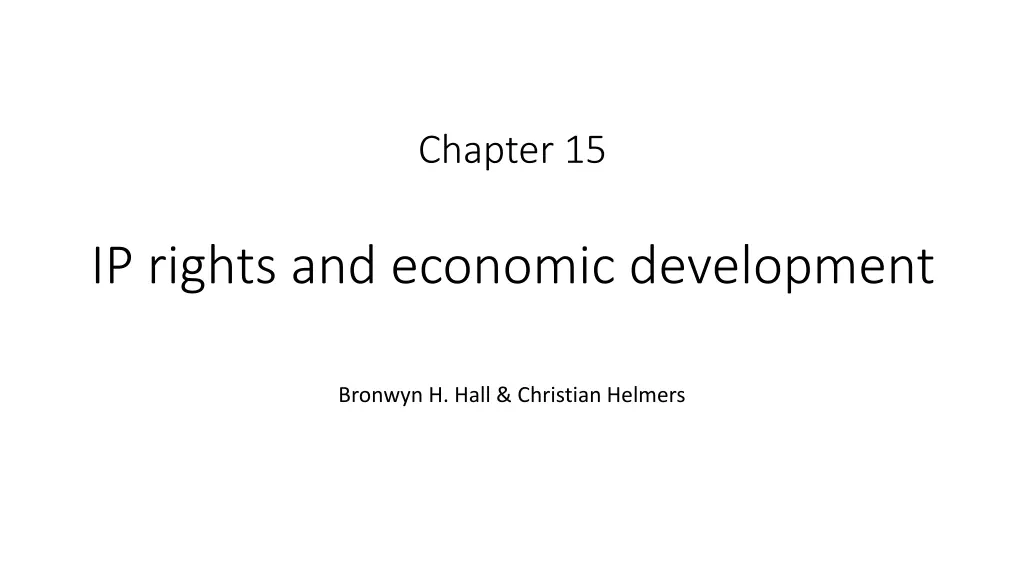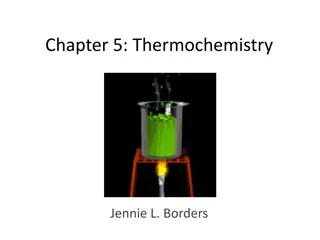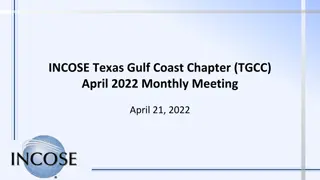
Intellectual Property Rights in Developing Economies
Explore the role of intellectual property rights in developing economies, with a focus on patents, trademarks, and industrial designs. Learn about the impact of IP protection on economic development, technology transfer, and domestic innovation in low and middle-income countries.
Uploaded on | 0 Views
Download Presentation

Please find below an Image/Link to download the presentation.
The content on the website is provided AS IS for your information and personal use only. It may not be sold, licensed, or shared on other websites without obtaining consent from the author. If you encounter any issues during the download, it is possible that the publisher has removed the file from their server.
You are allowed to download the files provided on this website for personal or commercial use, subject to the condition that they are used lawfully. All files are the property of their respective owners.
The content on the website is provided AS IS for your information and personal use only. It may not be sold, licensed, or shared on other websites without obtaining consent from the author.
E N D
Presentation Transcript
Chapter 15 IP rights and economic development Bronwyn H. Hall & Christian Helmers
Overview Stylized facts about the use of IP by residents of developing countries. Theory: optimal IP policy as a function of a country s level of economic development. Impact of patent protection on technology transfer to developing countries. Impact of patent protection on domestic innovation in developing countries. Patent protection and economic growth. Patents and pharmaceuticals in developing countries. 2024 Hall & Helmers Ch. 15 2
Introduction What is the role of IP rights in developing economies? Increased importance as role of knowledge in the economy has increased. Heavily debated topic: interests of large or more highly developed economies may conflict with smaller or less developed economies. Residents of least developed countries make almost no use of IP protection. Even residents in middle income countries use patents very little (with the exception of China), although they do use utility models, trademarks, and industrial designs to some extent. 2024 Hall & Helmers Ch. 15 3
Some facts Few patents are filed in low and middle income countries, with the exception of China. 2024 Hall & Helmers Ch. 15 4
Some facts Similarly, the rate of patent by residents is very low in low and middle income countries, with the exception of China. 2024 Hall & Helmers Ch. 15 5
Some facts Chemical and especially pharmaceutical patenting is relatively more important in middle and low income countries. 2024 Hall & Helmers Ch. 15 6
Patent protection of Apples swipe-to- unlock 2024 Hall & Helmers Ch. 15 7
Patent protection of Gileads Sovaldi 2024 Hall & Helmers Ch. 15 8
Some facts Trademark use is increasing in middle income countries, still low in low income countries. 2024 Hall & Helmers Ch. 15 9
Some facts Industrial design use is also increasing in middle income countries, still low in low income countries. 2024 Hall & Helmers Ch. 15 10
Some facts Utility model use declining in high income countries, increasing in China, fairly flat in middle income countries. 2024 Hall & Helmers Ch. 15 11
Some facts 2024 Hall & Helmers Ch. 15 12
Shares of worldwide IP royalty charges and receipts Almost all IP royalties paid to high income countries; share coming from middle income countries has increased over time from 10% to over 20%. Low income countries not involved in IP trade. 2024 Hall & Helmers Ch. 15 13
Some facts - summary Formal IP not very important in least developed countries and only marginally important in next tier. Trademarks and utility models more important in developing countries than patents. In less developed countries, patenting primarily in chemicals, especially pharmaceuticals, and patents usually held by non- residents. High income countries capture all of value in IP trade, mostly from each other, but with increasing shares from middle income countries. 2024 Hall & Helmers Ch. 15 14
Some facts - China Rapid growth of real GDP per capita, roughly 5.5% per annum between 1985 and 2020. 8-9% per annum growth of patenting and utility models over 30 years, almost all by residents. Economic growth and industrialization explain only part of increase in IP use. China introduced current patent system shortly after Deng Xiaoping adopted the Open Door Policy in 1978. Amended several times throughout 1980s and 1990s. Revised comprehensively as part of National IP Strategy in 2008. Revision reflected fact that imitation was no longer viable strategy as China moved to technology frontier in some areas. Policy shift triggered incentive programs to increase patenting activity of domestic firms. 2024 Hall & Helmers Ch. 15 15
Optimal IP policy IP systems generally determined at country level, with some international cooperation. Determining IP policy at country level ignores roles of international trade and knowledge spillovers. TRIPS (Trade-Related aspects of Intellectual Property Rights) agreement negotiations revived earlier questions about the optimal IP policy for countries at different development levels. Several models of optimal IP policies in the global economy (e.g.,Grossman and Lai 2004, Scotchmer 2004, Angeles 2005). 2024 Hall & Helmers Ch. 15 16
Grossman-Lai (G-L) model Two steps: Determine optimal policy for a single economy. Two economies (north and south, differing development levels) that trade. Assumptions: Every period n of differentiated goods invented and marketed. Monopoly price if patented, perfectly competitive if not. All goods have fixed lifetime of *. = discount rate. M = Market size in terms of GDP. Present discounted value of a dollar: ($1) * [1 exp( PDV T = *)/ ] 2024 Hall & Helmers Ch. 15 17
Grossman-Lai model one country Patent strength: Length of life <= * Enforcement strength Can show leads to single index of strength: [1 exp( )] = Invention of new goods a flow (t), given by CES function of human capital and research labor. All labor earns same wage w and enters research until marginal product falls to w. 2024 Hall & Helmers Ch. 15 18
Grossman-Lai model one country Use all these assumptions to derive welfare W(0) at time zero when patent system introduced. Composed of Wages to production labor LY Consumer surplus and profits under monopoly (Cm+ ) CS and profits under competition after patent expires Cc(T*- ) Put these together: ( ) (0) ( W M C w L = + + + M C T ) ( * ) Y m c G-L maximize this expression with respect to patent strength and obtain the following expression to define the optimal : * where is the responsiveness of innovation to patent strength m m c C C C = + T C c 2024 Hall & Helmers Ch. 15 19
Grossman-Lai model one country Equation shows that optimal patent protection is stronger when: 1. Useful product life * is longer. 2. Consumers are more patient (lower ). 3. Innovation responds more to patent strength (higher ). Also, decreasing returns in research means that in larger markets, weaker patent protection needed to induce R&D. If research production function Cobb-Douglas, optimal policy invariant to market size. 2024 Hall & Helmers Ch. 15 20
Grossman-Lai model two countries Assume two countries with different wage rates w, human capital H, and market size M, higher in North (N) than South (S). Same setup as before, with national treatment for inventors in each country; no parallel imports so price discrimination between countries possible; free trade. Each country benefits from markups on its own production due to patents; consumers in both countries bear cost in form of monopoly pricing. Resulting equilibrium asymmetric, characterized by: = + + = + * M T = for , S N i i C C C C i c m i m c M M N N S S where /( ) is the share of worldwide production taking place in country . i i i N S G-L use this to show Nash equilibrium and that optimal patent strength weaker for open economies than closed. 2024 Hall & Helmers Ch. 15 21
Optimal patent policy in global economy Conclusions of G-L: Optimal policy is stronger in North than South. Achieving efficiency relative to Nash equilibrium requires increased strength in at least one country. Under reasonable assumptions, harmonized policy produces gains for North, ambiguous results for South. Scotchmer (2004) adds public funding as alternative to patent protection: Shows more innovative country prefers higher harmonized protection. In general, most models show that harmonization leads to higher than optimal IP protection in the less developed countries. 2024 Hall & Helmers Ch. 15 22
Patents and development Historically patent systems develop in parallel with innovative economic growth (chicken-egg problem): Venice glass industry and the first invention patents. UK had patent protection during industrial revolution, but innovation without patents in Europe chemicals in 19C Germany (process but not product); Cornish pumping equipment (response to aggressive patent enforcement by Watt); Lyons silk weaving cooperative. 19C US no national treatment until Paris convention of 1883: Encouraged local tech development and learning by imitation. Taiwan little use of IP until imitation strategy successful. Korea used mainly utility (petty) patents in early stages of development; little foreign patenting until 1988 (Kim 2003; Lee & Kim 2010). Japan - Postwar system - one claim per patent, utility models, pre-grant opposition, early disclosure designed for incremental/adaptive invention. China - Introduction of modern patent system in 1985 (Paris convention) joined PCT in 1994, TRIPS in 2001, now emphasizing IP strategy. 2024 Hall & Helmers Ch. 15 23
How do patents help learning in developing economies? Patent publication, patent licensing: Of limited value without accompanying tacit knowledge (e.g. Vaitsos (1972) finds all patent licenses in Andean countries accompanied by knowhow transfer) Some evidence that reading patents useful for non-English speakers, especially in Japan. New capital goods, imitation, reverse engineering, technology transfer by multinational corporations (MNC) to their subsidiaries in the country: All these affected by the development level in the destination country. Patent protection helpful if the country has absorptive capacity to imitate imported technology. Technology spillovers from MNC subsidiaries to other firms in the country may be limited by patents and firm strategies. 2024 Hall & Helmers Ch. 15 24
Two questions about patents and tech development Does stronger patent protection encourage technology transfer? How does it affect behavior of foreign firms? Stronger IP protection in the host country should encourage (or at least not discourage) transfer of technology mostly confirmed empirically. Does stronger patent protection encourage technology development? How does it affect behavior of domestic firms? Stronger IP could encourage their innovative activities, but can also discourage imitation and inhibit learning and catchup less evidence and ambiguous results. 2024 Hall & Helmers Ch. 15 25
Two questions (cont.) The first question is easier to answer but the second is more important: 1. Foreign firms: stronger IP protection in the host country should encourage (or at least not discourage) transfer of technology. Note that this may or may not help local development. IP will be more important in developing countries at higher levels of development that have a capacity for imitation. 2. Domestic firms: stronger IP could encourage their innovative activities, but can also discourage imitation and inhibit learning and catchup. Again, this is a more important consideration at higher levels of development; IP system hardly used in the least developed countries. 2024 Hall & Helmers Ch. 15 26
Some tech transfer evidence Trade in knowledge-intensive goods relative to other goods increased post-TRIPS, controlling for various dates of TRIPS implementation in developing countries (Delgado et al., 2013) Early survey evidence that US multinationals evaluate IP enforcement before making investment abroad; empirical evidence on FDI in 16 developed countries supports this: Mansfield (1994), Lee and Mansfield (1996). Survey of R&D lab location choice (Thursby and Thursby 2006). Royalty payments, affiliate R&D spending, and foreign patent applications increase for US multinationals following IP reforms in 16 foreign countries, mostly middle income (Branstetter, Fishman, and Foley, 2006). Increasing patent protection has a positive impact on manufacturing imports in developing countries (Maskus and Penubarti, 1995). Country risk more important than IP rights in promoting technology transfer in chemical processing (Fosfuri, 2004). 2024 Hall & Helmers Ch. 15 27
Tech transfer evidence - summary For middle income countries that already have innovative capacity or capable of imitation: Both technology licensing and FDI respond to stronger IP regimes. Quality of technology transferred rises, and there is a shift toward licensing (markets for technology). Very low income countries see little response to changes in IP regimes. IP rights are not very highly ranked by MNCs as an influence on technology transfer/FDI, except for R&D facilities and very advanced technologies. 2024 Hall & Helmers Ch. 15 28
Domestic innovation and the patent system Historical evidence that strengthening or introducing a patent system may not increase inventive activity in a country, although lack of patents directs invention toward those that can be protected by secrecy. Ginarte-Park index of patent strength today is higher at higher development levels. Composed of five factors: 1. Extent of subject matter coverage. 2. Membership in international treaties including TRIPS. 3. Duration of protection. 4. Enforcement mechanisms. 5. Restrictions on patent rights (compulsory licensing; working requirement). 2024 Hall & Helmers Ch. 15 29
Ginarte-Park index of patent strength Predicting G-P Index: For higher income countries, R&D intensity and market freedom predict strength. For lower income countries, openness and market freedom predict strength, little impact of R&D. GDP per capita does not enter equation in presence of other variables. 2024 Hall & Helmers Ch. 15 30
Patent strength and R&D Evidence on domestic innovative effort in response to patent strength: 32 countries in 1985, 1990, and 1995: one unit increase in G-P index of patent strength associated with an absolute increase in R&D intensity of one percentage point (Kanwar and Evenson 2003). 35 countries during 1965-2000: G-P index has little impact on domestic R&D and patent filings over all, but at higher levels of development, patent strength does impact R&D and domestic patent filings positively (Allred and Park 2007). Note that both studies have relatively few observations from the least developed countries, due to lack of data. 2024 Hall & Helmers Ch. 15 31
Patents and economic growth Does the possible increase in innovation associated with patents translate to higher economic growth and development? Challenging question to answer given the simultaneity between economic development, technological development, and the choice of patent system. Granger causality tests find that GDP growth and patent quality measures are simultaneous, but that causality is stronger from patent quality to growth (Hasan and Tucci 2010). Good example of cross-country patent-growth literature: Hu and Png (2013): 34 manufacturing industries in 72 countries 1981-2000. Ask if patent strength in a country has a higher impact on those industries with high US patent intensities (controls for country and industry differences). Patent strength does matter for industry growth, and impact increases after TRIPS, and for higher income countries. 2024 Hall & Helmers Ch. 15 32
Pharmaceutical patents in developing countries Debate over IP in developing countries centers on pharma patents (for good reasons related to the lifesaving properties of some new pharmaceuticals). Pharma patents are probably the most valuable patents and also the relatively most patented in developing countries. Use and need for pharmaceuticals differs from high income countries (Kremer 2002): Smaller market size Different disease environment Weak health care systems Regulatory problems 2024 Hall & Helmers Ch. 15 33
Differing disease environment Communicable diseases including HIV/Aids, malaria, and tuberculosis are a more prevalent cause of death in low income countries. 2024 Hall & Helmers Ch. 15 34
Pharmaceutical policy questions Justification for use of patents to protect pharma product innovation is need to recoup high R&D costs including clinical trials. Consequence is high prices especially relative to developing country incomes. Patents may not induce a socially optimal mix of product innovation: Vaccines versus drugs taken over a whole lifetime. Medicines for diseases prevalent in low income countries. Other mechanisms suggested: Prizes, patent buyouts Shared patent pools for further development Compulsory licensing Guaranteed purchase Use of secondary patents to extend patent life (see Chapter 16). 2024 Hall & Helmers Ch. 15 35
Patents and pharma innovation Do pharma product patents increase R&D spending? Qian (2007) 26 countries with pharma patents 1978-2002 + matched control countries: No increase in R&D or US patents from product pharma patent introduction. However, increases at higher levels of GDP per capita. IP strength has inverted U impact conditional on other variables. Kyle & McGahan (2009) variation in TRIPS introduction of pharma patents, 1990-2006, at disease level: Strong association between pharmaceutical patents and R&D effort for diseases that are prevalent in high income countries. No association for neglected diseases prevalent in low income countries. 2024 Hall & Helmers Ch. 15 36
Patents and pharma diffusion Do pharma product patents affect diffusion? Cockburn, Lanjouw, and Schankerman (2016) - 642 new drugs launched in 76 countries,1983 2002: Price regulation delays launch (introducing price controls increases lag by 25-80%). Longer and stronger patents speed up launch (lag reduced 55% by long patent). Similar results for countries at all income levels. Kyle and Qian (2014) 716 drugs, 60 countries, 2000-2013. Compare drugs pre- and post-TRIPS compliance patents speed launch, increase price and quantity. Price discrimination across countries does not depend on patent coverage of the drug. Price premium for patented drugs smaller post-TRIPS. 2024 Hall & Helmers Ch. 15 37
Summary Economic development accompanied by increased attention to and use of IP rights. However, link somewhat broken by the advent of TRIPS harmonization. Economic theory predicts that IP or patent protection will tend to harmonize upward. Empirically: For middle income countries with moderate levels of human capital, patent protection encourages innovation investment and catchup, and becomes stronger as the country develops. For low income countries, patents are almost irrelevant, and are mostly used by non- residents. Most important area of patenting in developing countries is pharmaceuticals: Patents typically speed launch of new drugs in these countries. Do not increase research in neglected diseases. Do not increase research in low income countries. 2024 Hall & Helmers Ch. 15 38






















